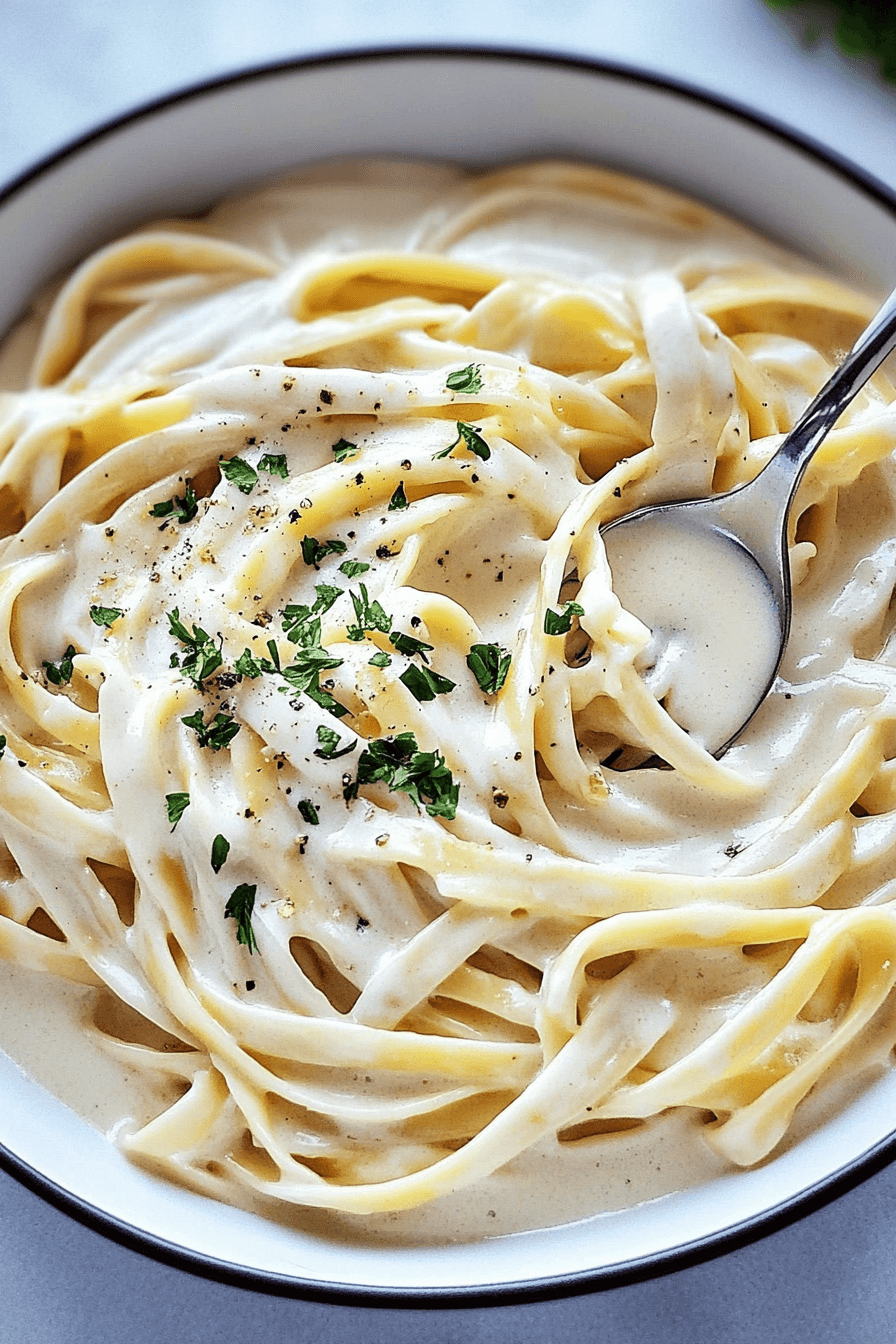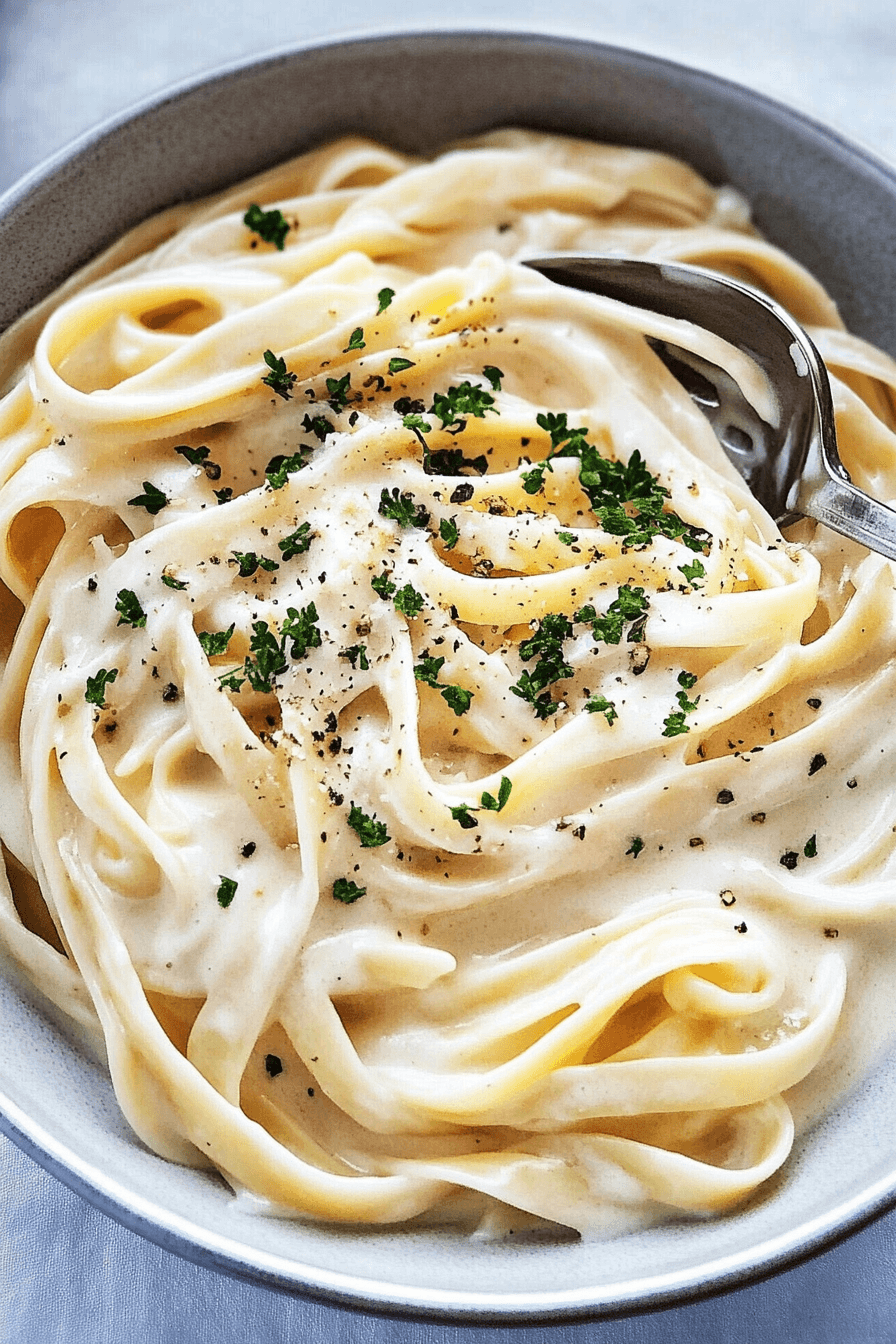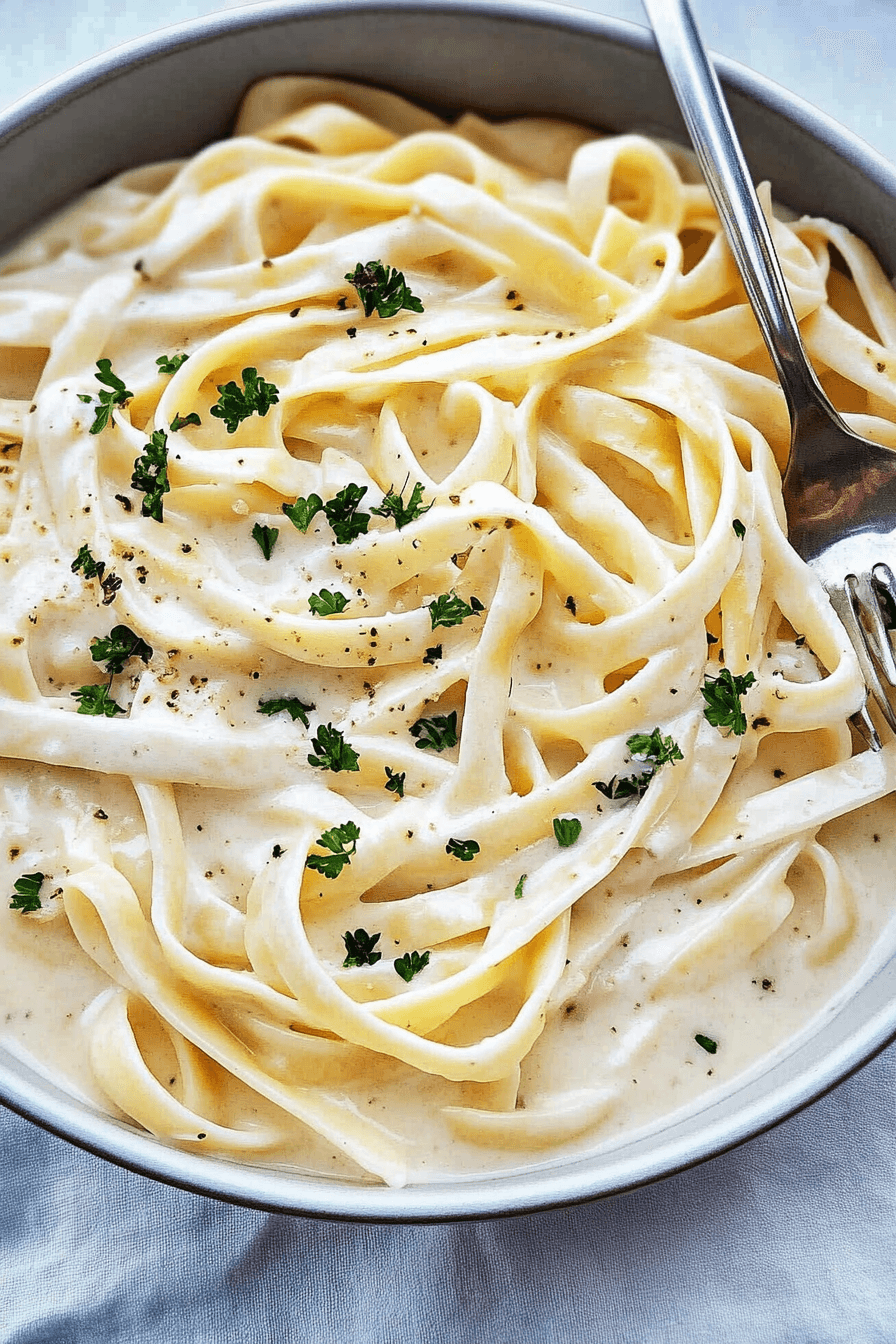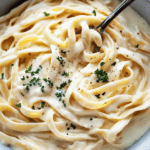Introduction to Fettuccine Alfredo
Fettuccine Alfredo is a beloved Italian classic that has captured the hearts and palates of countless food enthusiasts around the world. Originating in Rome, this dish is celebrated for its rich, creamy consistency that melds perfectly with the tender fettuccine pasta. Easy to prepare, Fettuccine Alfredo embodies simplicity and elegance—a combination that makes it a favorite go-to meal for busy parents, students, and professionals. Whether you’re indulging in a comforting Sunday dinner or introducing your taste buds to new culinary experiences, this recipe promises to deliver a plate full of warmth and satisfaction.
Benefits and Advantages of Fettuccine Alfredo
Fettuccine Alfredo offers several compelling advantages that make it a standout choice in any cooking repertoire. Its preparation is straightforward, taking just about 30 minutes to create a meal that tastes as if it could be served in an Italian trattoria. Health-conscious individuals appreciate its versatility, as the dish can easily be adapted to meet dietary preferences with simple substitutions, such as gluten-free pasta or low-fat cheeses. The rich and creamy sauce provides a comforting embrace that speaks to the soul, making it an ideal meal for family gatherings and intimate dinners. By seamlessly incorporating these variations, Fettuccine Alfredo caters to diverse palates and continues to maintain its title as a timeless classic.

Ingredients Overview
Essential Ingredients for Fettuccine Alfredo
- Fettuccine Pasta: 14 ounces of fresh or dried fettuccine. The pasta serves as the foundation of this classic dish and its broader shape facilitates holding onto the creamy sauce.
- Unsalted Butter: 1/2 cup. Adds richness and forms a silky base for the sauce, ensuring a decadent flavor.
- Fresh Parmesan Cheese: 1 1/2 cups, freshly grated. Essential for a creamy and smooth sauce, avoid pre-grated cheese as it often contains additives that prevent a perfect melting process.
- Heavy Cream: 1 cup (optional for American style). It provides an extra creamy texture, though traditionally, the Italian version relies mostly on butter and cheese.
- Salt: To taste. Used for seasoning the pasta water and adjusting the dish flavor.
- Freshly Ground Black Pepper: To taste. Adds a subtle hint of spice to balance the richness.
- Nutmeg: Pinch (optional). Complements the sauce with a slight nutty aroma.
For those seeking vegan or gluten-free alternatives, consider substituting regular fettuccine with gluten-free versions made from rice or chickpeas. Nutritional yeast can replace Parmesan cheese for a nutty, cheesy flavor in vegan variants.
Dietary Substitutions to Customize Your Fettuccine Alfredo
To cater to various dietary preferences, Fettuccine Alfredo can be adapted in several ways:
- Vegan Option: Utilize vegan butter and a combination of almond milk and nutritional yeast to replace the richness of dairy products. Choose vegan pasta to complete the transformation.
- Lactose-Free: Opt for lactose-free cream and cheese products which are now widely available.
- Low-Calorie: Replace heavy cream with a light, low-fat version or unsweetened almond milk to reduce calorie content.
Such substitutions allow the beloved Fettuccine Alfredo to align with more dietary needs without losing the comforting essence of its original flavors.
How to Prepare the Perfect Fettuccine Alfredo: Step-by-Step Guide
Crafting a perfect Fettuccine Alfredo requires attention to simplicity and quality of ingredients. Follow these steps for a sublime dining experience:
First Step: Cook the Fettuccine
- Begin by bringing a large pot of generously salted water to a boil. The salt enhances the pasta’s flavor.
- Add fettuccine to the boiling water, stirring occasionally to prevent sticking. Cook until the pasta reaches “al dente” (firm to the bite), typically 8-10 minutes for dried pasta.
- Reserve 1 cup of the pasta cooking water, then drain the fettuccine without rinsing to preserve its starchiness.
Second Step: Prepare the Alfredo Sauce
- While the fettuccine boils, melt the unsalted butter in a large skillet over medium heat. Optionally, lightly sprinkle nutmeg for a nuanced flavor.
- Pour heavy cream into the skillet with melted butter, if using. Stir frequently to combine them into a unified mixture, retaining a smooth texture.
- Gradually add the freshly grated Parmesan cheese to the mixture, stirring consistently. Allow the cheese to melt slowly to form a creamy sauce.
Third Step: Combine Pasta and Sauce
- Introduce the cooked fettuccine to the skillet filled with Alfredo sauce. Toss gently to coat the pasta thoroughly in the rich mixture.
- If the sauce appears too thick, incorporate small amounts of the reserved pasta water gradually, stirring until you reach the desired consistency.
Fourth Step: Season to Perfection
- Season the pasta with freshly ground black pepper and salt to taste. Remember, frequent small tastings help you customize to your preference.
- Serve immediately for best results, garnished with extra Parmesan cheese or chopped parsley for added freshness and color.
By following these steps, Fettuccine Alfredo can be tailored to meet specific dietary restrictions without sacrificing its classic, creamy essence.

Mastering Fettuccine Alfredo: Advanced Tips and Variations
Creating a rich, creamy Fettuccine Alfredo is an art that can be mastered with a few key techniques. Achieving the perfect texture and flavor revolves around choosing the right ingredients and understanding how they interact. Here are some expert tips that will help you take your Fettuccine Alfredo to the next level.
Advanced Tips for Perfect Alfredo
- Freshly Grated Cheese: The cornerstone of authentic Alfredo sauce is freshly grated Parmesan cheese. Pre-shredded cheese contains additives that prevent clumping, which can interfere with smooth melting.
- Heat Control: Use a gentle heat when melting butter and combining the sauce. Overheating may cause the butter to separate or the sauce to become oily.
- Reserve Pasta Water: Save some pasta water to adjust the sauce’s consistency. The starchy water helps the sauce adhere to the pasta, creating a silken texture.
Delicious Variations to Try
While the classic Fettuccine Alfredo is delicious in its simplicity, there are endless possibilities to adapt and personalize this beloved dish.
- Protein Additions: Add cooked chicken, shrimp, or scallops to elevate the dish. Decadent Creamy Garlic Butter Lobster Tails would be an exquisite pairing.
- Vegetable Enhancements: Incorporate sautéed mushrooms, roasted garlic, or spinach to introduce new flavors and textures. For a similar idea, check out our version of Stir Fry with Shrimp, Eggs & Cucumber.
- Herb Infusions: Toss in freshly chopped herbs like parsley or basil, or a sprinkle of nutmeg to deepen the flavor profile.
Trying these variations will not only keep your meal exciting but also allow you to customize this classic dish to suit your taste and dietary preferences.
How to Store Fettuccine Alfredo: Best Practices
Proper storage techniques are essential to maintain the fresh taste and creamy texture of Fettuccine Alfredo. Here are some tried-and-true methods to store your Alfredo and keep it delicious:
Refrigeration Tips
- Use Airtight Containers: Transfer leftover pasta to an airtight container to prevent it from absorbing other odors in the fridge.
- Consume Quickly: For optimal taste and texture, consume refrigerated Alfredo within 3-4 days.
Freezing Instructions
- Freeze in Portions: Freezing individual portions allows easy reheating and also helps maintain quality.
- Label and Date: Clearly label the container with the date to track freshness, and try to consume within 2 months for best results.
Reheating Guidelines
- Gentle Reheating: Reheat Alfredo sauce gently on the stovetop, stirring frequently and adding a splash of milk or water to revive the creamy texture.
- Microwave Caution: If using a microwave, heat in short bursts, stirring between intervals to achieve even heating.
These storage and reheating techniques ensure that your Fettuccine Alfredo remains just as creamy and satisfying as when it was first prepared. To learn more about the history and origins of this dish, visit [fettuccine alfredo history](https://en.wikipedia.org/wiki/Fettuccine_Alfredo) and [Italian fettuccine heritage](https://www.italiaregina.it/fettuccine-history/).

Nutritional Value of Fettuccine Alfredo
Understanding the nutritional value of Fettuccine Alfredo can help those watching their dietary intake prepare and enjoy this dish more mindfully. Traditionally, Fettuccine Alfredo is well-known for its richness, made primarily with fettuccine pasta, butter, and Parmesan cheese. This combination results in a meal that is delightfully creamy but also high in calories and fat.
Caloric Content and Macros
A typical serving of Fettuccine Alfredo contains around 1200 calories, with about 75 grams of fat, which is predominantly from the butter and cheese. The protein content, usually derived from the Parmesan cheese, is approximately 25 grams. The carbohydrates, majorly from the pasta, tally around 85 grams per serving. These values might vary slightly depending on portion sizes and additional ingredients like cream or protein such as chicken.
Vitamins and Minerals
Beyond macronutrients, Fettuccine Alfredo offers some essential vitamins and minerals. It contains calcium and vitamin A, both predominantly found in Parmesan cheese. Vitamin A supports vision and immune function, while calcium is crucial for bone health.
Dietary Adjustments for Health-Conscious Eaters
For those aiming to reduce the calorie count, consider substituting half of the butter with olive oil. Also, utilizing low-fat cheese can significantly trim down the fat content. Adding vegetables like broccoli or spinach not only boosts fiber but also introduces more vitamins. To cut down on carbohydrates, using spiralized zucchini instead of traditional pasta can be a great, low-carb alternative.
Remember, while the classic Fettuccine Alfredo is indeed indulgent, with careful ingredient selection, it can be adapted to various dietary preferences. For more information on fettuccine pasta and its origins, you can visit Wikipedia’s Fettuccine Alfredo page or explore the history of fettuccine on Italia Regina.
FAQs: Frequently Asked Questions About Fettuccine Alfredo
1. What are the main ingredients of Fettuccine Alfredo?
The key ingredients in a traditional Fettuccine Alfredo are fettuccine pasta, butter, and Parmesan cheese. The Americanized version of the dish often includes heavy cream for added richness.
2. How did Fettuccine Alfredo become famous?
Fettuccine Alfredo gained popularity in the 1920s when Hollywood stars Mary Pickford and Douglas Fairbanks sampled it at Alfredo di Lelio’s restaurant in Rome. Their endorsement helped popularize the dish in America.
3. Can I add cream to the traditional Fettuccine Alfredo recipe?
While the original Italian recipe for Fettuccine Alfredo doesn’t use cream, American variations often include it for a creamier texture. Adding cream is entirely optional and a matter of personal preference.
4. How do I prevent the Alfredo sauce from curdling?
To avoid the sauce from curdling, ensure that you combine the butter and cream or milk at a low simmer, not a rapid boil. Gradually incorporate grated Parmesan cheese off the heat, allowing it to melt smoothly into the sauce.
5. Can I make Fettuccine Alfredo healthier?
Yes, you can adjust the ingredients to make a healthier version. Opt for whole wheat pasta, use olive oil instead of butter, or incorporate vegetables for added nutrients. Reducing the amount of cheese can also help lower the fat content.
For more delicious recipes and variations of classic dishes, be sure to check out our Tofu Stir Fry Recipe or our rich and savory Creamy Alfredo Lasagna Soup on Valentina Recipes.
Print
Fettuccine Alfredo Recipe—Rich and Creamy
- Total Time: 40 minutes
Description
🍝 Indulge in the rich, creamy goodness of Fettuccine Alfredo—a timeless Italian classic that brings comfort and flavor in every bite! 😋✨
🧀 With its perfect blend of butter, cream, and Parmesan, this dish is a must-try for anyone craving a quick, satisfying, and luxurious meal! 🍽️🔥
Ingredients
Fettuccine pasta
Butter
Parmesan cheese
Heavy cream (optional, for American version)
Salt (optional, to taste)
Black pepper (optional, to taste)
Pasta water (if needed)
Instructions
1. Boil a large pot of salted water.
2. Add fettuccine pasta and cook until al dente, following package instructions.
3. Reserve about one cup of pasta water before draining.
4. In a large pan, melt butter over medium-low heat.
5. Pour in heavy cream and stir until fully combined. (Note: This step is for the American version.)
6. Reduce heat to low and let the sauce simmer for a few minutes while stirring.
7. Add freshly grated Parmesan cheese and continue stirring until smooth.
8. Toss the drained pasta into the sauce, coating it evenly.
9. If the sauce is too thick, slowly add reserved pasta water until desired consistency is reached.
10. Season with salt and pepper if needed.
11. Serve immediately while hot for the best texture and flavor.
12. Optionally, garnish with more Parmesan cheese and fresh parsley.
Notes
Use freshly grated Parmesan cheese for a smoother, creamier sauce.
Reserve some pasta water to adjust the sauce’s consistency if needed.
Serve immediately for the best texture and flavor.
- Prep Time: 30
- Cook Time: 10
- Category: Main Course
- Method: Stovetop
- Cuisine: Italy

